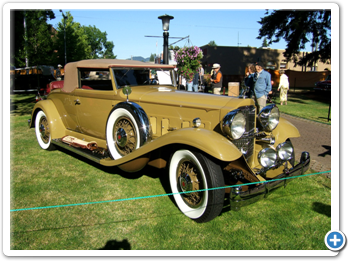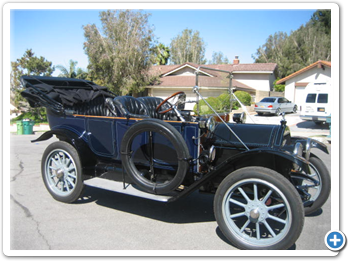|
Lately there is plenty of talk among classic car owners about the shifting demographics of their car clubs. This year the Classic Car Club of America (CCCA) surveyed its membership and found their average age is 68. Obviously, this trend is not sustainable.
How then, can these clubs recruit younger people who are interested in 65, 75, and even 85 year old cars? The answer may lie within the ranks. What was it that attracted the existing younger members to the older cars and the classic clubs?
In 1998, CCCA, HCCA, and Packards of Oregon member Ken Krolikoski started out with a 1964 Ford Thunderbird Convertible and moved to progressively older cars, one at a time.
“I always liked old cars,” says Ken. “On a rainy Saturday afternoon, which is always dangerous because you don’t have anything to do, I went over to Matthew’s Memory Lane Motors. There was a shiny red 1964 T-bird with a fresh paint job. It was a driver, but I couldn’t see past the paint, right? After I got it home a few months later, a neighbor showed me a flyer for the Sherwood Car Show. I didn’t know anything about car shows as I had never been to one except for the Forest Grove Concours. So I entered and I ended up getting first place in the convertible class. There were about 300 cars and I got Best Convertible for that show. I thought, ‘Hey I’ve got a great car!’ And then I started going to more car shows, but I wasn’t getting very many first place awards as it was very competitive. I thought, ‘How do I get that plastic $5 trophy?’ which is pretty funny, but it’s amazing what gets the competition juices flowing. However I was enjoying myself as I was meeting new friends at the shows”
“That winter I made some upgrades to the interior and had some parts re-chromed. The next year, I made some more upgrades and then thought about the engine and engine compartment which had been sprayed flat black. Somebody said ‘Where is it leaking?’ and I said, ‘Well, it’s leaking everything, oil, antifreeze, you name it, it was leaking.’ So I had it rebuilt and then went back to the Sherwood Show. At the show this guy parked next to me with a ’40 Packard Darrin that he’d hot-rodded, with a Viper engine. The people loved his car and I said, ‘I just don’t know how I beat you two years ago.’ He said, ‘You silly guy, I beat you! I got Best of Show!’ I wasn’t paying attention but that show’s policy said that if you won your class and also Best of Show, they’d move the guy in second place up to first in the class. That way more people get trophies. The awards were “People’s Choice,” where the car owner participants do the voting. So maybe I got two votes and he got 298 and the reason I got two votes was because they didn’t see his car!”
As is often the case with collectors, one car leads to another. In Ken’s case the T-Bird led to a truck--one that he first saw at a car show.
“I was parked two cars away from this guy who had this ’55 Chevy pickup,” says Ken. “I liked the looks of it and two years later the truck was for sale. I bought it in an hour--I had this habit of buying things quickly. Well, it turns out it was all shined up but it still had the original rear end in it. It couldn’t go above 50 mph, probably 45, and it didn’t have power steering or power brakes so it was a bear to drive. I installed a new rear end, power steering and power brakes, and put a blower on it. But every time I had to choose between the T-bird and the truck, I would always take the Thunderbird, so I decided to sell the truck. That’s when I realized that people don’t like long-bed trucks and I had a hard time selling it. But I finally sold it to a guy on E-Bay; he took it to his first car show and won a trophy so he was happy.”


“For the longest time, I just had the Thunderbird and then I met Bill Becker and saw his Rolls Royce. One day in the summer of 1995 I decided I wanted a big classic car, like the Rolls, so I started to do some research. I didn’t know anything about the Classic Car Club or Packard and finally I narrowed my choice to a Packard. In the late ‘20’s, early ’30’s, that was the leading luxury car manufacturer. I bought a Packard Deluxe Eight Coupe Roadster from Tom Crook in Auburn, Washington, and I like a car maintained to show standards, so I started upgrading it and now it’s almost perfect.”
One of the things Ken likes about his Packard is its rarity. This, coupled with his interest in brass-era automobiles led him to sell his Thunderbird and purchase a rare 1912 Cadillac Model 30 Touring.
“The Cadillac is different from the Packard because it’s not a show car, it’s a good driver,” says Ken. “And like the Packard, its unique--I’ve never seen a 1932 Packard Deluxe Eight or a 1912 Cadillac at a show. In fact, I’ve never seen another 1912 Cadillac!”
Ken does much of his own restoration work. Not having a history in auto mechanics or painting, he has developed his skills and outfitted his garage on an as-needed basis.
“The funny thing about that first car show is that it got me going on the Thunderbird restoration,” says Ken. I called it a “rolling restoration,” where I would do a part of the car every year. That led me to buying a lift for the garage because I wanted to work underneath the car. With my mechanical abilities, I didn’t feel safe using jack stands.”
Along with the lift, Ken purchased painting and sanding equipment allowing him to restore the Packard to Concours quality.
“I took two weeks to paint the rear of my Packard’s front bumper, says Ken. “I had it off the car and it always bothered me because the back had some rough areas. It was plated, but they never polished it, and they just painted it flat black. So, I sanded it all down and applied some filler and now the back of the bumper is perfect. It looks pretty damn good for the back of a bumper! But I have the time and the patience over the winter to do these types of projects. The steering wheel and steering column also needed to be repainted so I turned my pocket garage (the smallest of the three bays) into a paint booth using PVC and plastic sheeting.”
Nice as the car is, Ken isn’t afraid to experiment with new restoration methods when necessary.
“I typically paint everything three, four, five times, partly because I don’t know what I’m doing. Also I want things to be perfect only if it only goes on the engine. That way I’m perfecting my skills for areas of the cars when it will matter. The steering wheel took me six tries because my paint gun just put too much paint on and it would run. I tried using a smaller gun I had bought at a garage sale and then the paint was coming out too thin. Finally I figured out how to put the paint on without running, but it still was too dry. The guy at Quality Paint figured my garage was cold so he sold me some cold temperature reducer, which makes the paint dry like it was room temperature. Unfortunately I neglected to tell him I had a 220V electric heater in the garage. Getting the right reducer solved the dry paint problem. I sanded it with 1000 grit paper and then 2000 and 4000 grit sanding pads with a palm DA (dual action) sander and then used a buffing wheel to bring out the gloss. I couldn’t use my 8 inch rotary buffer on the steering wheel, so I found these buffing pads for my die grinder, which spins at 20,000 rpm, right? You’re suppose to polish at no more than 3000 RPM so I kept feathering the on lever for the die grinder to keep the speed reasonable. It actually came out pretty well. I’m probably the only guy stupid enough to try that! Later, I found a pneumatic buffer for $40 at Harbor Freight with a three-inch wheel--it would be perfect for something like that.”
|